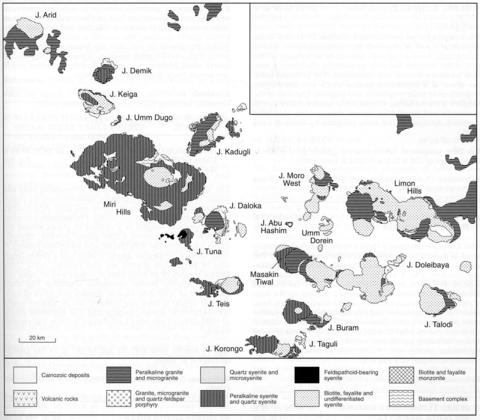stripes
The Masakin Hills extend over an area of 34x15 km. Outcrops of Precambrian basement granitic gneisses and metasedimentary rocks are numerous on the north side of the hills but rare to the south. A small area of rhyolitic volcanic rocks occurs towards the centre of the occurrence. Eight cross-cutting intrusive units were identified by Curtis and Brinkmann (1985) and these progressed with time towards the east-southeast. The rocks range from syenites which are barely alkaline, as indicated by slight marginal increases in sodium in pyroxenes, to peralkaline quartz syenites with sodic amphibole, to granites containing arfvedsonite-riebeckite, aegirine, biotite and accessory zircon and fluorite. The main peralkaline granite, known as the Reika granite, is situated in the northwest of the complex, but the granite in the northeast, the Jebel Doleibaya granite, is non-alkaline being a biotite adamellite to granodiorite; traces of monazite and cassiterite were detected by XRD in this granite and fluorite occurs in veins. Jebel Tuli is a small isolated hill of about 2x1 km lying to the north of the Masakin Hills and composed almost entirely of coarse to pegmatitic syenite. Analyses of five samples of the Reika peralkaline granite and four of the Jebel Doleibaya biotite granite are given by Curtis and Lenz (1985).
CURTIS, P. and BRINKMANN, K. 1985. The geology of younger intrusive alkali complexes in the southwestern Nuba Mountains, Sudan. Geologisches Jahrbuch, 63: 3-41.CURTIS, P. and LENZ, H. 1985. Geological and geochronological investigations of selected alkali igneous complexes in the Nuba Mountains, southern Kordofan, Sudan. Geologisches Jahrbuch, 69: 3-24.

